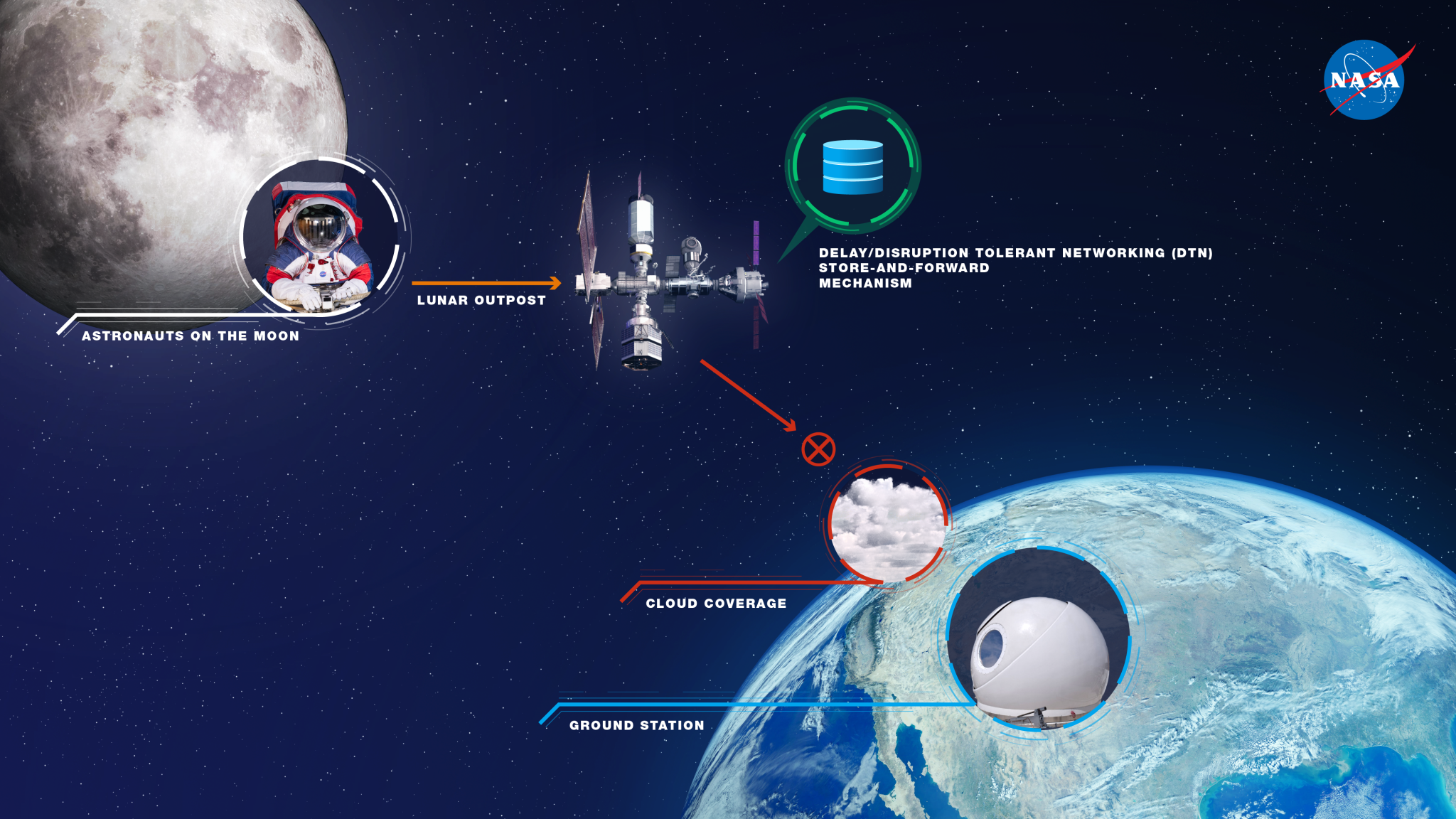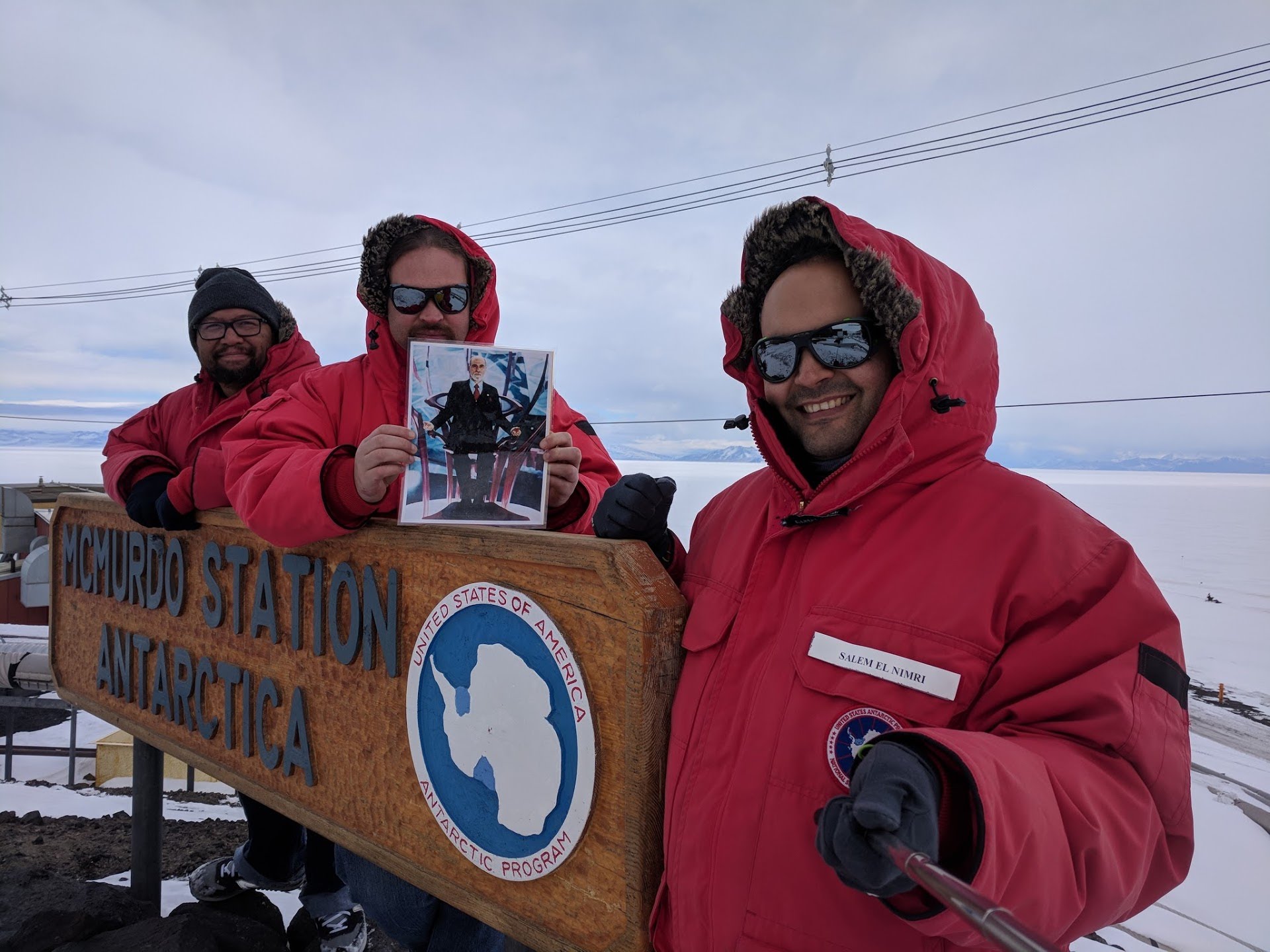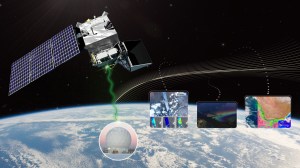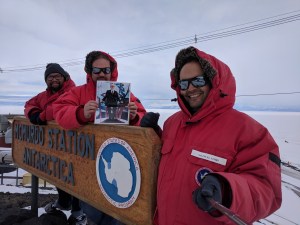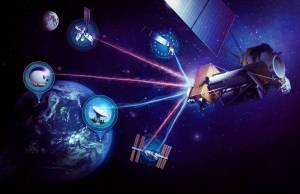Delay/Disruption Tolerant Networking
Delay/Disruption Tolerant Networking (DTN) is a suite of standard protocols that use information within the data stream (headers attached to data units) to accomplish end-to-end data delivery through network nodes. DTN is a foundational capability for creating the Solar System Internet and will be bring internet-like functionality to space communications. The capability enables data delivery in situations that involve:
- Disconnections (e.g., end-to-end link unavailability)
- Delays (e.g., Deep Space missions)
- Data rate mismatches (e.g., high data rate Science downlinks but lower rate terrestrial connections)
A DTN architecture is a store-and-forward communications architecture in which source nodes send DTN bundles through a network to destination nodes.
The DTN protocol suite can operate in tandem with the terrestrial IP suite or it can operate independently. DTN provides assured delivery of data using automatic store-and-forward mechanisms. Each data packet that is received is forwarded immediately if possible, but stored for future transmission if forwarding is not currently possible but is expected to be possible in the future. As a result, only the next hop needs to be available when using DTN.
DTN Benefits
DTN Enables Science and Exploration
- Increases science data return through interoperability and more efficient link utilization
- Enables communications between and through constellations and swarms of smallsats
- Facilitates science across distributed platforms
- Reduces of operational complexity
- Enables responsive mission operations
- Increases scalability
- Enables reuse
- Increases interoperability
- Facilitates streamlined operations and more efficient use of personnel
The DTN suite also contains network management, security, routing and quality-of-service capabilities, which are similar to the capabilities provided by the terrestrial Internet suite.
- Improved Operations and Situational Awareness: The DTN store-and-forward mechanism along with automatic retransmission provides more insight into events during communication outages that occur as result of relay or ground station handovers and poor atmospheric conditions, and significantly reduces the need to schedule ground stations to send or receive data, which can sometimes require up to five days of planning before a transmission takes place.
- Interoperability and Reuse: A standardized DTN protocol suite enables interoperability of ground stations and spacecraft operated by any space agency or private entity with space assets. It also allows NASA to use the same communication protocols for future missions (low-Earth orbit, near-Earth orbit or deep space).
- Space Link Efficiency, Utilization and Robustness: DTN enables more reliable and efficient data transmissions resulting in more usable bandwidth. DTN also improves link reliability by having multiple network paths and assets for potential communication hops.
- Security: The DTN Bundle Protocol Security allows for integrity checks, authentication and encryption, even on links where not previously used.
Mission Types & Potential DTN Benefits:
Delay/Disruption Tolerant Networking (DTN) can benefit all types of missions. It is currently being used on the International Space Station. DTN has also been used by low-Earth orbit, lunar, and deep space missions, demonstrating its utility for complex future missions.
DTN Myths and Facts
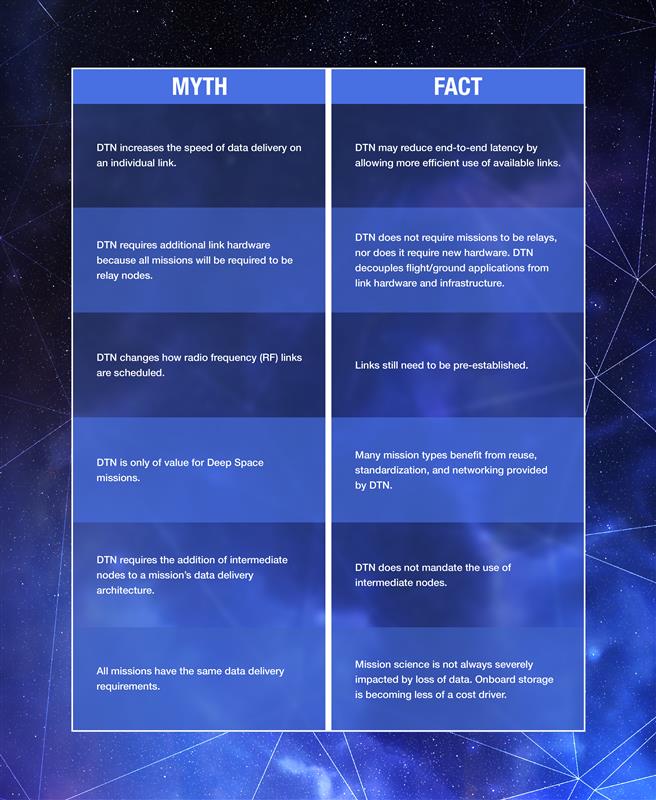
DTN Success Stories
From Antarctic research stations and Earth-observing spacecraft to the International Space Station and missions at the Moon and beyond, NASA has successfully demonstrated Delay/Disruption Tolerant Networking (DTN) in a variety of orbits and environments. The lessons learned continue to guide DTN’s current and future operational use.
Antarctica Demonstration
On November 20, 2017, NASA engineers at the McMurdo Station in Antarctica used DTN to transmit a simple smartphone selfie all the way to the International Space Station. The image was bundled by DTN software and began its journey via the McMurdo ground station and the Tracking and Data Relay Satellite (TDRS) to NASA’s White Sands Complex, then routed through a series of DTN nodes en route to Marshall Space Flight Center in Huntsville, Alabama. From there, another TDRS link relayed the data to the station, where the Telescience Resource Kit (TReK) payload reassembled and displayed the photo. The demonstration—a vivid analog for interplanetary internet capabilities—highlights DTN’s strength in enabling reliable communications across networks that lack a consistent path, whether it’s remote Earth locations or deep-space missions.
Operational on PACE
As of 2024, NASA’s PACE (Plankton, Aerosol, Cloud, ocean Ecosystem) mission is the first operational science mission to integrate DTN into both the spacecraft and the Near Space Network’s ground infrastructure. DTN is embedded within the PACE flight software and four antennas on Earth – located in Alaska, Virginia, Chile, and Norway – enabling secure storage and forwarding of critical data during communication disruptions. This ensures that vital housekeeping information such as battery status, orbital parameters, and science data are transmitted reliably once communication paths reopen. With PACE orbiting about 250 miles above Earth, the DTN-enhanced network enables the mission to “phone home” efficiently, downlinking up to 3.5 terabytes of science data daily through 12 to 15 transmissions.
HDTN Demonstration
In 2024, NASA sent over 500 pet photos to the space station via laser communications links. The images flowed from optical ground stations in California and Hawaii to the Laser Communications Relay Demonstration (LCRD) in geosynchronous orbit, which then relayed the data to a payload on the space station. High-Rate Delay/Disruption Tolerant Networking (HDTN) was used to reliably store, reassemble, and forward these files despite potential connectivity interruptions. The test showed that HDTN can operate at four times the speed of earlier DTN implementations and is capable of supporting high-bandwidth data transfers critical for future science and exploration missions.
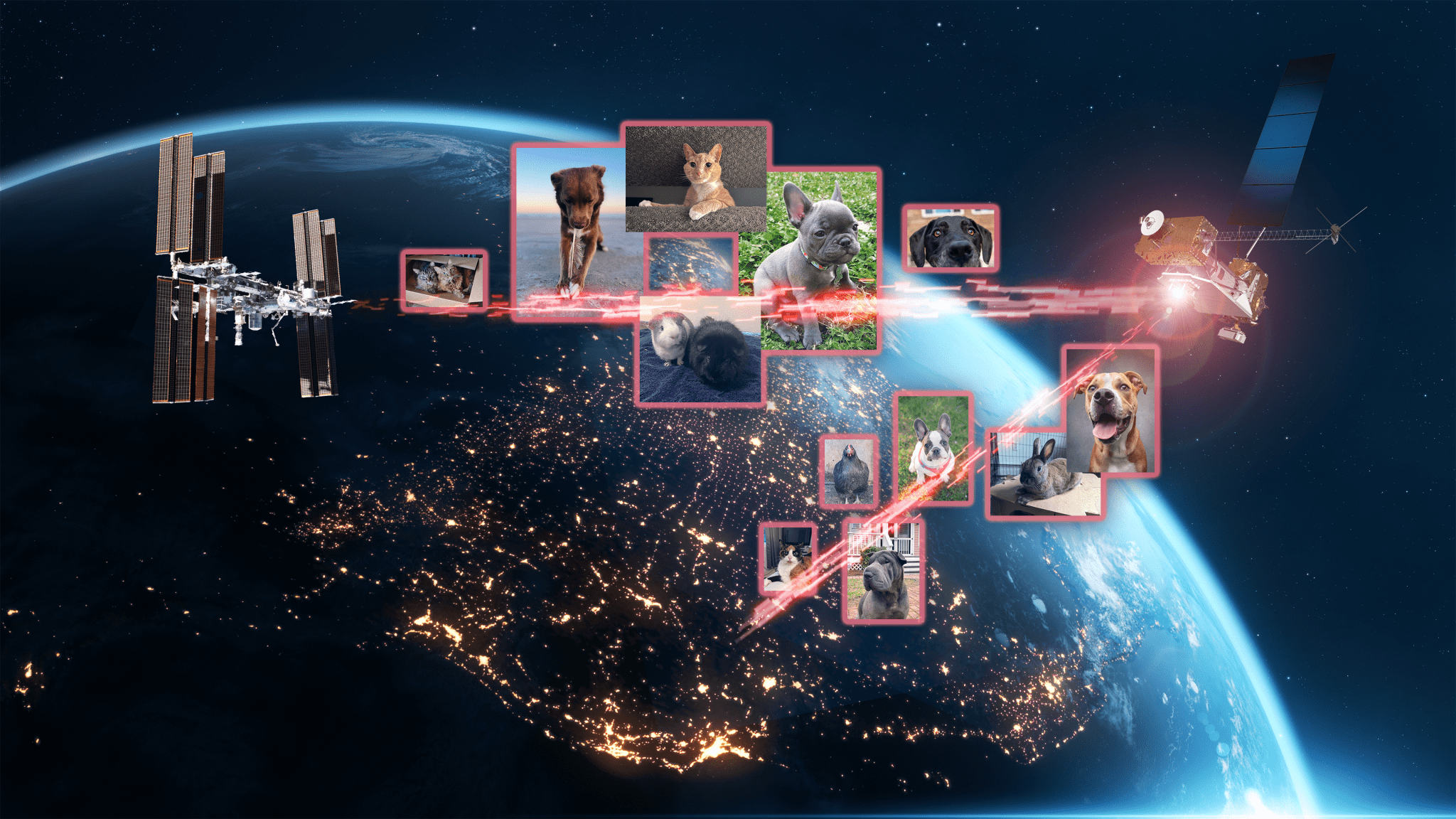
DTN Papers & Learning Resources
- Jones, Ross. “Deep Space Networking experiments on the EPOXI spacecraft.” AIAA Infotech @ Aerospace Conference, 29-31 March 2011. https://trs.jpl.nasa.gov/handle/2014/42087
- Schlesinger, Adam et al. “Delay/Disruption Tolerant Networking for the International Space Station (ISS).” https://ntrs.nasa.gov/archive/nasa/casi.ntrs.nasa.gov/20160014037.pdf
- Johnson, Sandra et al. “Delay Tolerant Networking on NASA’s Space Communication and Navigation Testbed.” CCSDS DTN Working Group, October 2016. https://ntrs.nasa.gov/archive/nasa/casi.ntrs.nasa.gov/20170004100.pdf
- Kraft, R. (2012). “NASA, ESA Use Experimental Interplanetary Internet to Test Robot From International Space Station.” NASA Press Release 12-391. Retrieved from https://www.nasa.gov/home/hqnews/2012/nov/HQ_12-391_DTN.html
- Martin S. & Cardone, M. (2018, 28 February). “METERON Operations Environment – Preparing Data Systems for Robotic Exploration.”*
- Fong, T. (2012) “Human Exploration Telerobotics Project Demonstrates Remote Operation of ‘Smart Spheres’ on Space Station.” Retrieved from https://ti.arc.nasa.gov/news/iss-spheres-demo/
- “Antarctic Selfie’s Journey to Space via Disruption Tolerant Networking.” https://www.nasa.gov/feature/antarctic-selfie-s-journey-to-space-via-disruption-tolerant-networking
- Davis, Faith et al. “Benefits of Delay Tolerant Networking for Earth Science Missions.” https://ntrs.nasa.gov/archive/nasa/casi.ntrs.nasa.gov/20120002041.pdf
- Suzuki, K. et al. (2014). “JAXA-NASA Interoperability Demonstration for Application of DTN under Simulated Rain Attenuation.” Retrieved from https://ntrs.nasa.gov/archive/nasa/casi.ntrs.nasa.gov/20140010962.pdf
- Israel, D. and Cornwell, D. (2014). “Disruption Tolerant Networking over LLCD’s Optical Links.” IPNSIG Space Technology Innovations Conference.*
- “Disruption Tolerant Networking Experiments with Optical Communications.”
- Introduction to Delay/Disruption Tolerant Networking (DTN)
- “The Benefits of Delay/Disruption Tolerant Networking (DTN) for Future NASA Science Missions”
- Presented at the 70th International Astronautical Congress. Summarizes the results of a NASA Science Mission Directorate (SMD) study that identified and verified the benefits that various types of SMD missions would realize by implementing DTN.
- “Delay/Disruption Tolerant Networking for the International Space Station (ISS)”
- Explains the architecture of the ISS DTN network, the operational support for the system, the results from integrated ground testing, and the future work for DTN expansion.
- Rationale, Scenarios, and Requirements for DTN in Space
- Contains background and explanatory material to support CCSDS Recommendations for a Delay-Tolerant Networking protocol suite. Describes the rationale, scenarios/use cases, and requirements for a proposed DTN service targeted at the space internetworking environment
- Delay and Disruption Tolerant Networks: A Tutorial
- Provides an overview of the DTN concept, the mechanisms and procedure it employs, how it compares to Internet Protocol, and applications of the technology (Developed by Forrest Warthman, Warthman Associates for the InterPlanetary Networking Special Interest Group




























